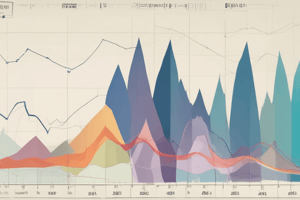Podcast
Questions and Answers
What is the primary purpose of a pie chart?
What is the primary purpose of a pie chart?
- To illustrate changes in a dependent variable at different levels of an independent variable.
- To plot relationships between two independent variables.
- To show the variance of a dataset over time.
- To visually display the proportion of parts that make up a whole. (correct)
How many slices are recommended to include in a pie chart to avoid clutter?
How many slices are recommended to include in a pie chart to avoid clutter?
- 2 to 4 slices.
- At least 10 slices.
- Exactly 8 slices.
- No more than 6 slices. (correct)
What indicates a strong relationship in a scatter plot?
What indicates a strong relationship in a scatter plot?
- A wild approximation of the best fit curve.
- Data points that are widely spread out without any pattern.
- A best fit curve that intersects most data points as a smooth straight line. (correct)
- A curve that has no intersection with the data points.
What does a wild approximation of the best fit curve in a scatter plot indicate?
What does a wild approximation of the best fit curve in a scatter plot indicate?
When constructing a bar graph, what data should be plotted on the Y-axis?
When constructing a bar graph, what data should be plotted on the Y-axis?
What aspect of a bar graph's title is most important?
What aspect of a bar graph's title is most important?
In a scatter plot, how are the dependent variables displayed?
In a scatter plot, how are the dependent variables displayed?
What is one key characteristic of scientific collaboration depicted in bar graphs?
What is one key characteristic of scientific collaboration depicted in bar graphs?
What is the primary purpose of using graphs in data representation?
What is the primary purpose of using graphs in data representation?
Which type of graph is best used for displaying trends over time?
Which type of graph is best used for displaying trends over time?
What should be included when labeling a graph?
What should be included when labeling a graph?
In an experimental setup, which variable is controlled and plotted on the independent axis?
In an experimental setup, which variable is controlled and plotted on the independent axis?
What is a characteristic use of a pie chart?
What is a characteristic use of a pie chart?
Which statement about scatter plots is true?
Which statement about scatter plots is true?
When should bar graphs be used instead of line graphs?
When should bar graphs be used instead of line graphs?
What is an ideal characteristic of data presented in tables and graphs?
What is an ideal characteristic of data presented in tables and graphs?
Flashcards are hidden until you start studying
Study Notes
Pie Charts
- A pie chart visually represents data as a circle divided into slices, each indicating a proportional part of a whole.
- Must be drawn to scale and ideally limited to about 6 slices to avoid clutter.
Scatter Plots
- Used to examine relationships between two dependent variables, each having its own axis.
- "Best fit curve" is employed to represent the data points; a smooth line suggests a strong correlation between variables, while a wild approximation indicates a weak or no relationship.
- Connecting dots directly is not proper; analysis requires deriving a best fit line.
Bar Graphs
- Effective for displaying data regarding scientific collaborations, such as co-authorships among scientists.
- Constructing bar graphs can involve students working in groups to analyze specific data sets like English Sparrow data.
- Elements of a bar graph include a clear title, labeled x-axis (independent variable) and y-axis (dependent variable).
Graphing Data
- Ability to organize data transforms raw information into comprehensible formats; includes creating data tables and various graph types (bar, line, pie chart, scatter plot).
- Graphing is essential for analyzing trends and making sense of complex data sets.
General Graphing Principles
- Aim for simplicity in designs, utilize titles summarizing data purpose, label units of measurement, and identify all axis components clearly.
- A legend may be used to clarify graph elements if necessary.
Importance of Graphing
- Graphs serve as visual tools to interpret large volumes of data, making findings accessible to broader audiences.
- Differentiation between variables:
- Independent Variable: the controlled variable plotted on the independent axis.
- Dependent Variable: responds to changes in the independent variable, plotted on the dependent axis.
Types of Graphs and Their Uses
- Bar Graphs: Ideal for grouped data in categories or ranges.
- Line Graphs: Summarize relationships and trends, tracking how multiple pieces of information vary over time by connecting data points.
Studying That Suits You
Use AI to generate personalized quizzes and flashcards to suit your learning preferences.




